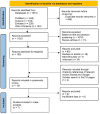Sedentary behavior and neck pain in children and adolescents; a systematic review and meta-analysis
- PMID: 36686056
- PMCID: PMC9808908
- DOI: 10.34172/hpp.2022.31
Sedentary behavior and neck pain in children and adolescents; a systematic review and meta-analysis
Abstract
Background: Sedentary behavior (SB) is considered a risk factor for musculoskeletal pain. We aimed to explore the association of sedentary behavior indicators with neck pain among children and adolescents. Methods: A comprehensive review was performed in different databases until the end of January 2022. Odds ratios (ORs) with 95% confidence intervals were used as desired effect sizes to evaluate the association between prolonged screen time or mobile phone (MP) usage and neck pain risk. Results: Among 1651 records, 15 cross-sectional studies were included in the systematic review, and 7 reports were included in the meta-analysis. Our results suggested a significant relationship between prolonged MP use and neck pain (OR=1.36, 95% CI=1.001-1.85, I2=40.8%, P value for heterogeneity test=0.119). Furthermore, a marginally insignificant association was found between prolonged screen time and neck pain (OR=1.13, 95% CI=0.98-1.30, I2=60.3%, P value=0.01); however, after sensitivity analysis and removing one study, this association became significant (OR=1.30, 95% CI=1.03-1.64). Moreover, a significant association between prolonged sitting time and neck pain was reported in two studies. Conclusion: Available good-quality evidence reveals a significant mild association between sedentary behavior and the risk of neck pain among children and adolescents. However, longitudinal studies with objective measurement tools are warranted. In particular, potential preventive educational programs are suggested for pediatrics to reduce sedentary behavior and neck pain.
Keywords: Cell phone use; Meta-analysis; Neck pain; Screen time; Sedentary behavior.
© 2022 The Author(s).
Figures
Similar articles
-
Sedentary behavior and neck pain in adults: A systematic review and meta-analysis.Prev Med. 2023 Oct;175:107711. doi: 10.1016/j.ypmed.2023.107711. Epub 2023 Sep 28. Prev Med. 2023. PMID: 37775083 Review.
-
The associations between sedentary behavior and neck pain: a systematic review and meta-analysis.BMC Public Health. 2025 Feb 4;25(1):453. doi: 10.1186/s12889-025-21685-9. BMC Public Health. 2025. PMID: 39905389 Free PMC article.
-
Sedentary behavior is associated with musculoskeletal pain in adolescents: A cross sectional study.Braz J Phys Ther. 2022 Sep-Oct;26(5):100452. doi: 10.1016/j.bjpt.2022.100452. Epub 2022 Oct 13. Braz J Phys Ther. 2022. PMID: 36257097 Free PMC article.
-
Association between sedentary behavior and low back pain; A systematic review and meta-analysis.Health Promot Perspect. 2021 Dec 19;11(4):393-410. doi: 10.34172/hpp.2021.50. eCollection 2021. Health Promot Perspect. 2021. PMID: 35079583 Free PMC article. Review.
-
Does sedentary behaviour cause spinal pain in children and adolescents? A systematic review with meta-analysis.Br J Sports Med. 2025 Mar 3;59(6):409-422. doi: 10.1136/bjsports-2024-108648. Br J Sports Med. 2025. PMID: 39438037 Free PMC article.
Cited by
-
Virtual Education Protocol for Sustainable Lifestyle Modifications.Int J Prev Med. 2025 Jun 30;16:40. doi: 10.4103/ijpvm.ijpvm_389_24. eCollection 2025. Int J Prev Med. 2025. PMID: 40726953 Free PMC article.
-
The Role of Stabilization Exercise in Preventing Pain and Postural Defects in Young Football Players.Healthcare (Basel). 2025 Aug 12;13(16):1983. doi: 10.3390/healthcare13161983. Healthcare (Basel). 2025. PMID: 40868599 Free PMC article.
-
Assessing the Impact of Smartphone Use on Neck Pain and Related Symptoms Among Residents in Jeddah, Saudi Arabia: A Cross-Sectional Study.Cureus. 2024 Jul 11;16(7):e64299. doi: 10.7759/cureus.64299. eCollection 2024 Jul. Cureus. 2024. PMID: 39130843 Free PMC article.
-
Associations between exposure to common technology devices and reported neck pain among Iranian school-age adolescents: a cross sectional study.BMC Musculoskelet Disord. 2023 Nov 13;24(1):883. doi: 10.1186/s12891-023-07010-8. BMC Musculoskelet Disord. 2023. PMID: 37957607 Free PMC article. Clinical Trial.
-
Screen Time and Its Health Consequences in Children and Adolescents.Children (Basel). 2023 Oct 8;10(10):1665. doi: 10.3390/children10101665. Children (Basel). 2023. PMID: 37892328 Free PMC article. Review.
References
Publication types
LinkOut - more resources
Full Text Sources





